Application of [Pt(II)(Tetra-Tert-Butylsalophen)] Complex within Organic Devices: Deep Red Emission, Bistable Light-Emitting Diodes and Operational Stability
Abstract
:1. Introduction
2. Materials and Methods
3. Results and Discussion
3.1. Host-Guest System
3.2. Negative Differential Resistance
3.3. Stability Investigations
3.3.1. Analysis of Characteristics Measured on Non-Doped Devices
3.3.2. Doping Effect on the Device Stability
- (i)
- Dipole formation by charge transfer (CT)—The current decrease could be explained by charge accumulation: the electrons are trapped by [Pt] leading to the formation of complex negatively charged [Pt]− and adjacent molecule would be positively charged (Alq3+). The formation of charged species tends to create [Pt]−–Alq3+ dipoles. The electron accumulation (within Alq3 layer and at the vicinity of NPD/Alq3 interface) would induce internal field (Eint) opposite to applied field, which tends to reduce electron mobility within Alq3 layer.
- (ii)
- Formation of conductive pathways—The preferred orientation of [Pt]−–Alq3+ dipoles would tend to create preferential electron pathways within Alq3 layer favoring local electron charge transport.
- (iii)
- Thermal energy release—The current resetting could be explained by electron–phonon and/or electron-electron scattering in conductive pathways [48,49,50]. The local heating would induce thermal assisted mechanisms: depolarization of [Pt]−–Alq3+ dipoles (i.e., thermally activated relaxation of electron captured by [Pt]) and thermal assisted injection of electron from the Alq3 layer to the NPD layer.
4. Conclusions
Supplementary Materials
Author Contributions
Acknowledgments
Conflicts of Interest
References
- Xu, H.; Chen, R.; Sun, Q.; Lai, W.; Su, Q.; Huang, W.; Liu, X. Recent progress in metal-organic complexes for optoelectronic applications. Chem. Soc. Rev. 2014, 43, 3259–3302. [Google Scholar] [CrossRef] [PubMed]
- Klaus, M.; Scherf, U. Organic Light Emitting Devices: Synthesis, Properties and Applications, 1st ed.; Wiley-VCH Verlag GmbH & Co. KGaA: Weinheim, Germany, 2006; ISBN 9783527312184. [Google Scholar]
- Yang, X.; Zhou, G.; Wong, W.-Y. Functionalization of phosphorescent emitters and their host materials by main-group elements for phosphorescent organic light-emitting devices. Chem. Soc. Rev. 2015, 44, 8484–8575. [Google Scholar] [CrossRef] [PubMed]
- Cheng, J.; Wei, K.; Ma, X.; Zhou, X.; Xiang, H. Synthesis and Photophysical Properties of Colorful Salen-Type Schiff Bases. J. Phys. Chem. C 2013, 117, 16552–16563. [Google Scholar] [CrossRef]
- Al Baldo, Y.E.; O’Brien, M.A.; You, D.F. Highly efficient phosphorescent emission from organic electroluminescent devices. Nature 1998, 395, 151–154. [Google Scholar] [CrossRef]
- Yersin, H. Triplet Emitters for OLED Applications. Mechanisms of Exciton Trapping and Control of Emission Properties. Top. Curr. Chem. 2004, 241, 1–26. [Google Scholar] [CrossRef]
- Lee, C.W.; Renaud, C.; LeRendu, P.; Nguyen, T.P.; Seneclauze, B.; Ziessel, R.; Kanaan, H.; Jolinat, P. Performance and defects in phosphorescent organic light-emitting diodes. Sol. Stat. Sci. 2010, 12, 1873–1876. [Google Scholar] [CrossRef]
- Renaud, C.; Nguyen, T.P. Study of trap states in polyspirobifluorene based devices: Influence of aging by electrical stress. J. Appl. Phys. 2009, 106, 053707. [Google Scholar] [CrossRef]
- Pekkola, O.; Gassmann, A.; Etzold, F.; Laquai, F.; von Seggern, H. Influence of triplet excitons on the lifetime of polymer-based organic light emitting diodes. Phys. Status Solidi (a) 2014, 211, 2035–2039. [Google Scholar] [CrossRef]
- King, S.M.; Cass, M.; Pintani, M.; Coward, C.; Dias, F.B.; Monkman, A.P.; Roberts, M. The contribution of triplet–triplet annihilation to the lifetime and efficiency of fluorescent polymer organic light emitting diodes. J. Appl. Phys. 2011, 109, 074502. [Google Scholar] [CrossRef] [Green Version]
- Zhang, Y.; Slootsky, M.; Forrest, S.R. Enhanced efficiency in high-brightness fluorescent organic light emitting diodes through triplet management. Appl. Phys. Lett. 2011, 99, 223303. [Google Scholar] [CrossRef]
- Meerheim, R.; Walzer, K.; Pfeiffer, M.; Leo, K. Ultrastable and efficient red organic light emitting diodes with doped transport layers. Appl. Phys. Lett. 2006, 89, 061111–061114. [Google Scholar] [CrossRef]
- Nowy, S.; Ren, W.; Elschner, A.; Lövenich, W.; Brütting, W. Impedance spectroscopy as a probe for the degradation of organic light-emitting diodes. J. Appl. Phys. 2010, 107, 054501. [Google Scholar] [CrossRef]
- Scholz, S.; Kondakov, D.; Lüssem, B.; Leo, K. Degradation mechanisms and reactions in organic light-emitting devices. Chem. Rev. 2015, 115, 8449–8503. [Google Scholar] [CrossRef] [PubMed]
- Blondel, B.; Delarue, F.; Lopes, M.; Ladeira-Mallet, S.; Alary, F.; Renaud, C.; Sasaki, I. Investigation of a sterically hindered Pt(II) complex to avoid aggregation-induced quenching: Applications in deep red electroluminescent and electrical switching devices. Synth. Met. 2017, 227, 106–116. [Google Scholar] [CrossRef]
- Che, C.; Kwok, C.; Lai, S.-W.; Rausch, A.; Finkenzeller, W.; Zhu, N.; Yersin, H. Photophysical Properties and OLED Applications of Phosphorescent Platinum(II) Schiff Base Complexes. Chemistry 2010, 16, 233–247. [Google Scholar] [CrossRef] [PubMed]
- Piest, H.; Anni, M.; Cingolani, R.; Gigli, G. Singlet to triplet excitation spectrum of thin film tris-(8-hydroxyquinolate)-aluminium in direct absorption. Synth. Met. 2008, 158, 1062–1066. [Google Scholar] [CrossRef]
- Burrows, H.D.; Fernandes, M.; Seixas de Melo, J.; Monkman, A.P.; Navaratnam, S. Characterization of the Triplet State of tris(8-hydroxyquinoline)aluminium(III) in Benzene Solution. J. Am. Chem. Soc. 2003, 125, 15310–15311. [Google Scholar] [CrossRef] [PubMed]
- Ruseckas, A.; Ribierre, J.C.; Shaw, P.E.; Staton, S.V.; Burn, P.L.; Samuel, I.D.W. Singlet energy transfer and singlet-singlet annihilation in light-emitting blends of organic semiconductors. Appl. Phys. Lett. 2009, 95, 183305. [Google Scholar] [CrossRef]
- Borowicz, P.; Nickel, B. The Kinetics of Joined Action of Triplet-Triplet Annihilation and First-Order Decay of Molecules in T1 State in the Case of Nondominant First-Order Process: The Kinetic Model in the Case of Spatially Periodic Excitation. J. Spectrosc. 2013, 2013, 346826. [Google Scholar] [CrossRef]
- Lin, J.; Ma, D. Origin of negative differential resistance and memory characteristics in organic devices based on tris(8-hydroxyquinoline) aluminum. J. Appl. Phys. 2008, 103, 124505. [Google Scholar] [CrossRef]
- Bozano, L.D.; Kean, B.W.; Deline, V.R.; Salem, J.R.; Scott, J.C. Mechanism for bistability in organic memory elements. Appl. Phys. Lett. 2003, 84, 607. [Google Scholar] [CrossRef]
- Chen, J.; Ma, D. Performance improvement by charge trapping of doping fluorescent dyes in organic memory devices. J. Appl. Phys. 2006, 100, 034512. [Google Scholar] [CrossRef]
- Yang, Y.; Ouyang, J.; Ma, L.H.; Tseng, R.J.; Chu, C.W. Electrical Switching and Bistability in Organic/Polymeric Thin Films and Memory Devices. Adv. Funct. Mater. 2006, 16, 1001–1014. [Google Scholar] [CrossRef]
- Mohd Sarjidan, M.A.; Basri, S.H.; Za’aba, N.K. Electroluminescence and negative differential resistance studies of TPD:PBD:Alq3 blend organic-light-emitting diodes. Bull. Mater. Sci. 2015, 38, 235–239. [Google Scholar] [CrossRef]
- Dearnale, G.; Stoneham, A.M.; Morgan, D.V. Electrical Phenomena in Amorphous Oxide Films. Rep. Prog. Phys. 1970, 33, 1129–1191. [Google Scholar] [CrossRef]
- Naber, R.C.G.; Asadi, K.; Blom, P.M.W.; de Leeuw, D.M.; de Boer, B. Organic nonvolatile memory devices based on ferroelectricity. Adv. Mater. 2010, 22, 933–945. [Google Scholar] [CrossRef] [PubMed]
- Chowdhury, A.; Biswas, B.; Mallik, B. Negative Differential Resistance and Photovoltaic Phenomena Observed in Nanostructured Organic Heterojunction. J. Nanosci. Nanotechnol. 2013, 13, 4134–4140. [Google Scholar] [CrossRef] [PubMed]
- Yee, M.; Yunus, W.M.M.; Talib, Z.A.; Kassim, A. Effect of thickness of tris(8-hydroxyquinolinato) aluminum on the photoluminescence and I–V characteristic of organic light emitting structure. Am. J. Appl. Sci. 2010, 7, 1215–1218. [Google Scholar] [CrossRef]
- Naka, S.; Okada, H.; Onnagawa, H.; Yamaguchi, Y.; Tsutsui, T. Carrier transport properties of organic materials for EL device operation. Synth. Met. 2000, 111, 331–333. [Google Scholar] [CrossRef]
- Cho, B.; Song, S.; Ji, Y.; Kim, T.W.; Lee, T. Organic Resistive Memory Devices: Performance Enhancement, Integration, and Advanced Architectures. Adv. Funct. Mater. 2011, 21, 2806–2829. [Google Scholar] [CrossRef]
- Ishii, M.; Taga, Y. Influence of temperature and drive current on degradation mechanisms in organic light-emitting diodes. Appl. Phys. Lett. 2002, 80, 3430–3432. [Google Scholar] [CrossRef]
- Zou, D.; Tutsui, T. Voltage shift phenomena introduced by reverse-bias application in multilayer organic light emitting diodes. J. Appl. Phys. 2000, 87, 1951–1956. [Google Scholar] [CrossRef]
- Aziz, H.; Popovic, Z.D.; Hu, N.X.; Hor, A.M.; Xu, G. Degradation mechanism of small molecule-based organic light-emitting devices. Science 1999, 283, 1900–1902. [Google Scholar] [CrossRef] [PubMed]
- Pavesi, L. Influence of dispersive exciton motion on the recombination dynamics in porous silicon. J. Appl. Phys. 1996, 80, 216–225. [Google Scholar] [CrossRef]
- Kakalios, J.; Street, R.A.; Jackson, W.B. Stretched-Exponential Arising from Dispersive Diffusion of Hydrogen in Amorphous Silicon. Phys. Rev. Lett. 1998, 59, 1037–1040. [Google Scholar] [CrossRef] [PubMed]
- Phillips, J.C. Stretched exponential relaxation in molecular and electronic glasses. Rep. Prog. Phys. 1996, 59, 1133–1207. [Google Scholar] [CrossRef]
- Jonscher, A.K. Dielectric relaxation in solids. J. Phys. D 1999, 32, R57–R70. [Google Scholar] [CrossRef]
- Féry, C.; Racine, B.; Vaufrey, D.; Doyeux, H.; Cinà, S. Physical mechanism responsible for the stretched exponential decay behavior of aging organic light-emitting diodes. Appl. Phys. Lett. 2005, 87, 213502–213504. [Google Scholar] [CrossRef]
- Ishii, M. Luminance decay mechanisms in organic light-emitting diodes. R&D Rev. Toyota CRDL 2003, 38, 55–60. [Google Scholar]
- Aziz, H.; Popovic, Z.; Xie, S.; Hor, A.; Xu, G. Humidity-induced crystallization of tris(8-hydroxyquinoline) aluminum layers in organic light-emitting devices. Appl. Phys. Lett. 1998, 72, 756–758. [Google Scholar] [CrossRef]
- Choi, J.W.; Kim, J.S.; Oh, S.Y.; Rhee, H.W.; Lee, W.H.; Lee, S.B. Degradation effect of polymer hole transport layer on organic electroluminescence device performance. Thin Solid Films 2000, 363, 271–274. [Google Scholar] [CrossRef]
- Shen, J.; Wang, D.; Langlois, E.; Barrow, W.A.; Green, P.J.; Tang, C.W.; Shi, J. Degradation mechanisms in organic light emitting diodes. Synth. Met. 2000, 111, 233–236. [Google Scholar] [CrossRef]
- Aziz, H.; Popovic, Z. Degradation Phenomena in Small-Molecule Organic Light-Emitting Devices. Chem. Mater. 2004, 16, 4522–4532. [Google Scholar] [CrossRef]
- Parker, I.D.; Cao, Y.; Yang, C.Y. Lifetime and degradation effects in polymer light-emitting diodes. J. Appl. Phys. 1999, 85, 2441–2447. [Google Scholar] [CrossRef]
- Stampor, W.; Kalinowski, J.; Di Marco, P.; Fattori, V. Electric field effect on luminescence efficiency in 8-hydroxyquinoline aluminum (Alq3) thin films. Appl. Phys. Lett. 1997, 70, 1935–1937. [Google Scholar] [CrossRef]
- Zou, D.; Yahiro, M.; Tsutsui, T. Spontaneous and reverse-bias induced recovery behavior in organic electroluminescent diodes. Appl. Phys. Lett. 1998, 72, 2484–2486. [Google Scholar] [CrossRef]
- Kim, N.; Domercq, B.; Yoo, S.; Christensen, A.; Kippelen, B.; Graham, S. Thermal transport properties of thin films of small molecule organic semiconductors. Appl. Phys. Lett. 2005, 87, 241908. [Google Scholar] [CrossRef]
- Silvestre, G.C.M.; Johnson, M.T.; Giraldo, A.; Shannon, J.M. Light degradation and voltage drift in polymer light-emitting diodes. Appl. Phys. Lett. 2001, 78, 1619–1621. [Google Scholar] [CrossRef]
- Kao, K.C. New theory of electrical discharge and breakdown in low-mobility condensed insulators. J. Appl. Phys. 1984, 55, 752. [Google Scholar] [CrossRef]
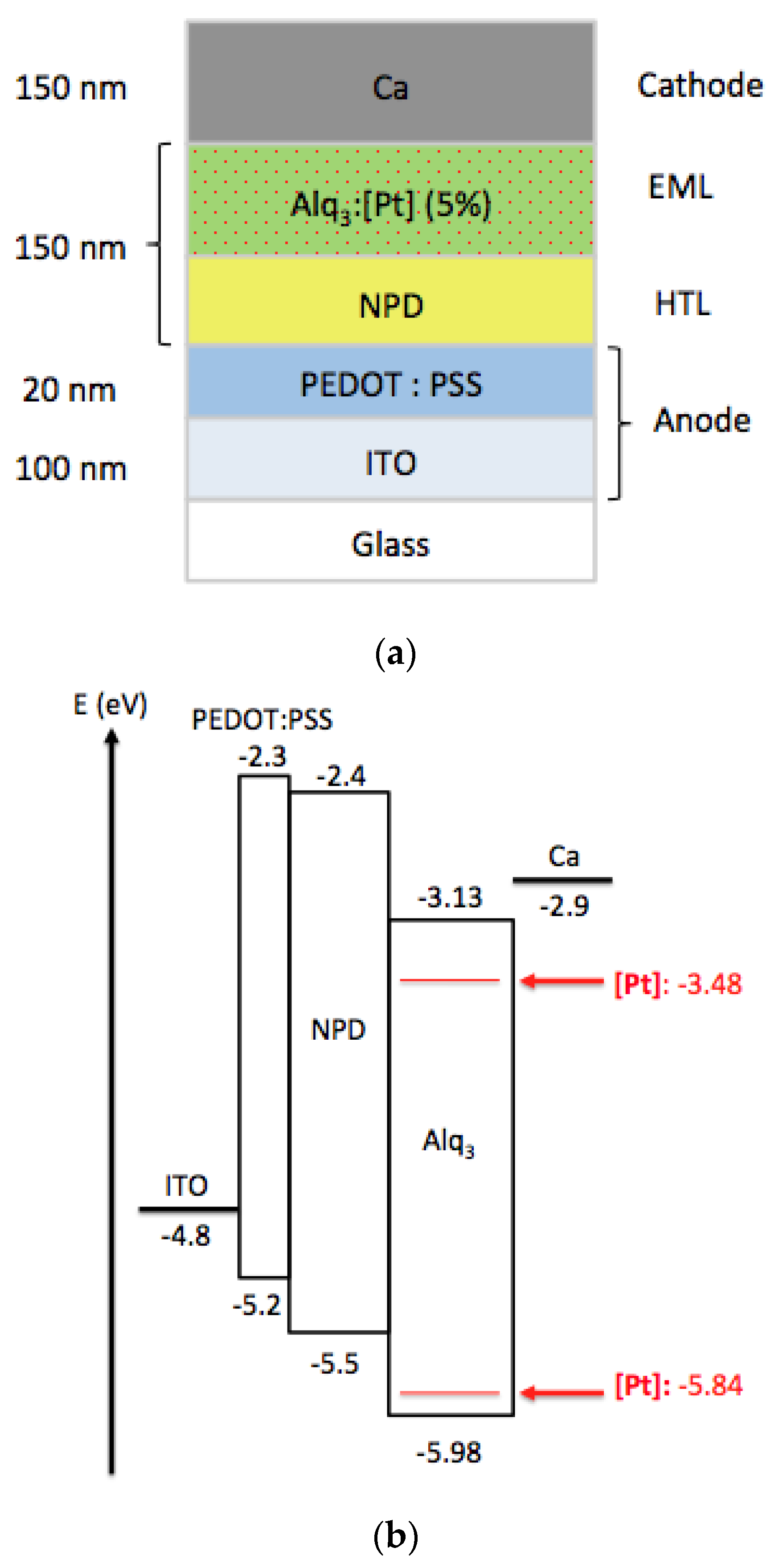
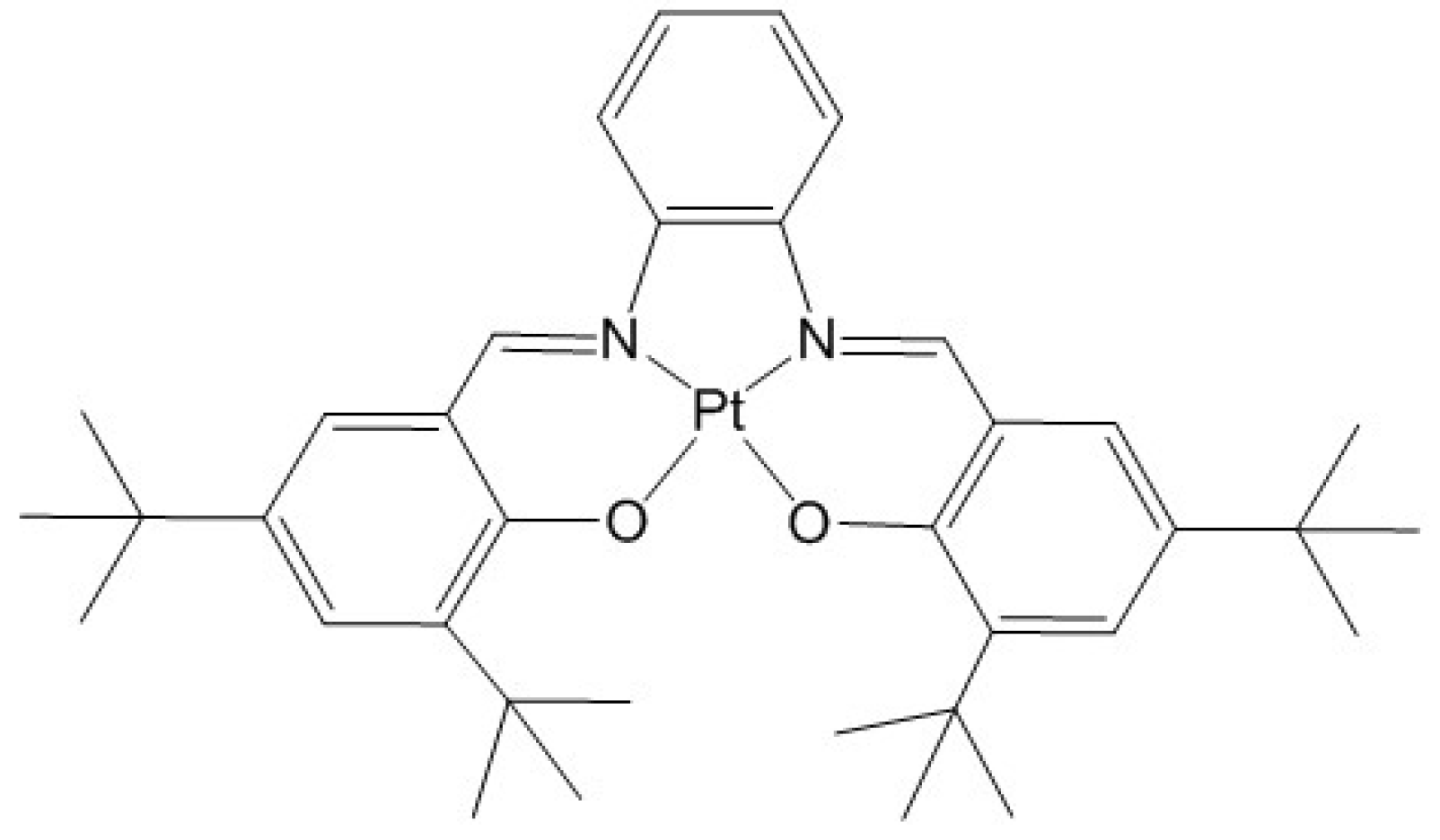
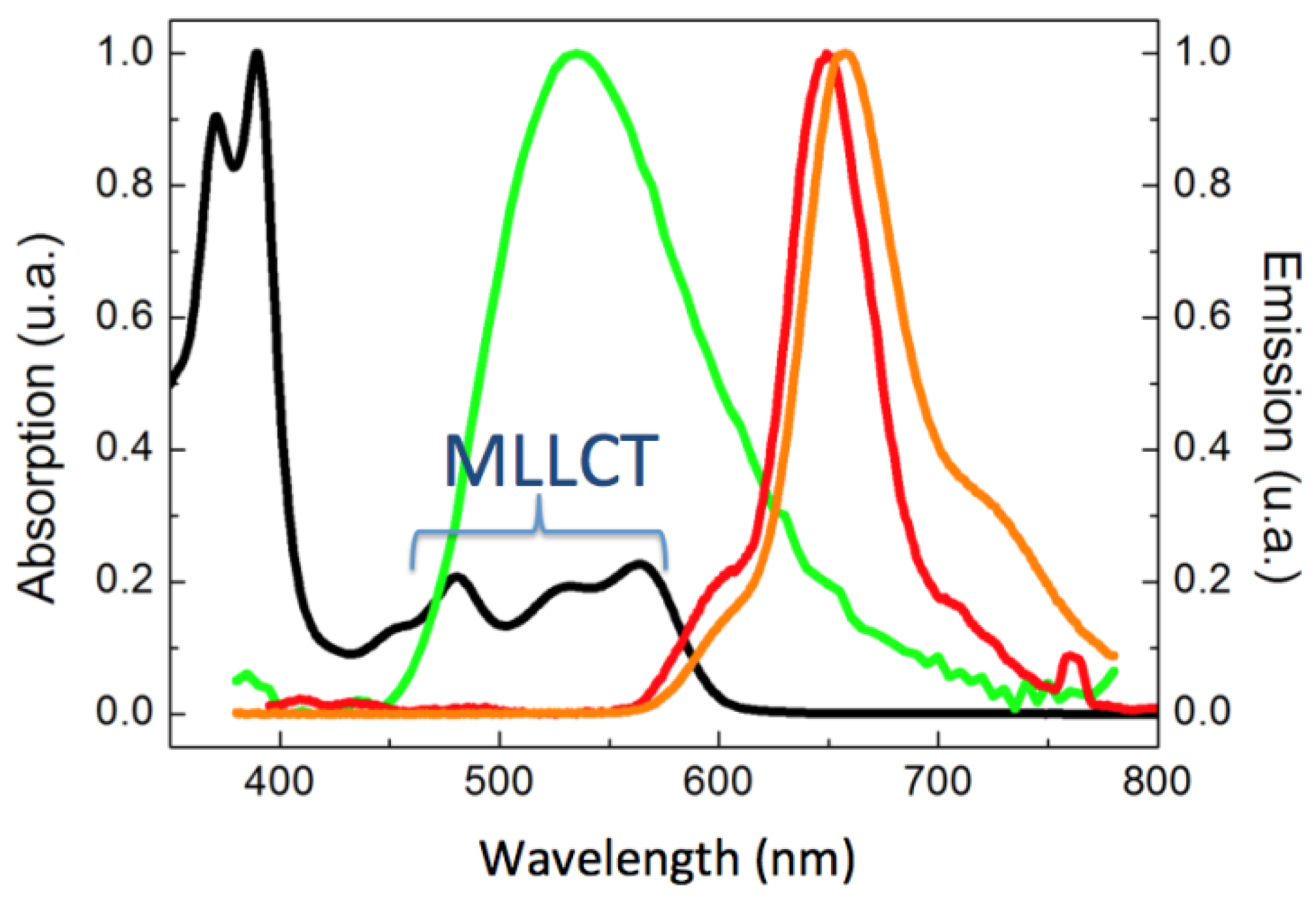

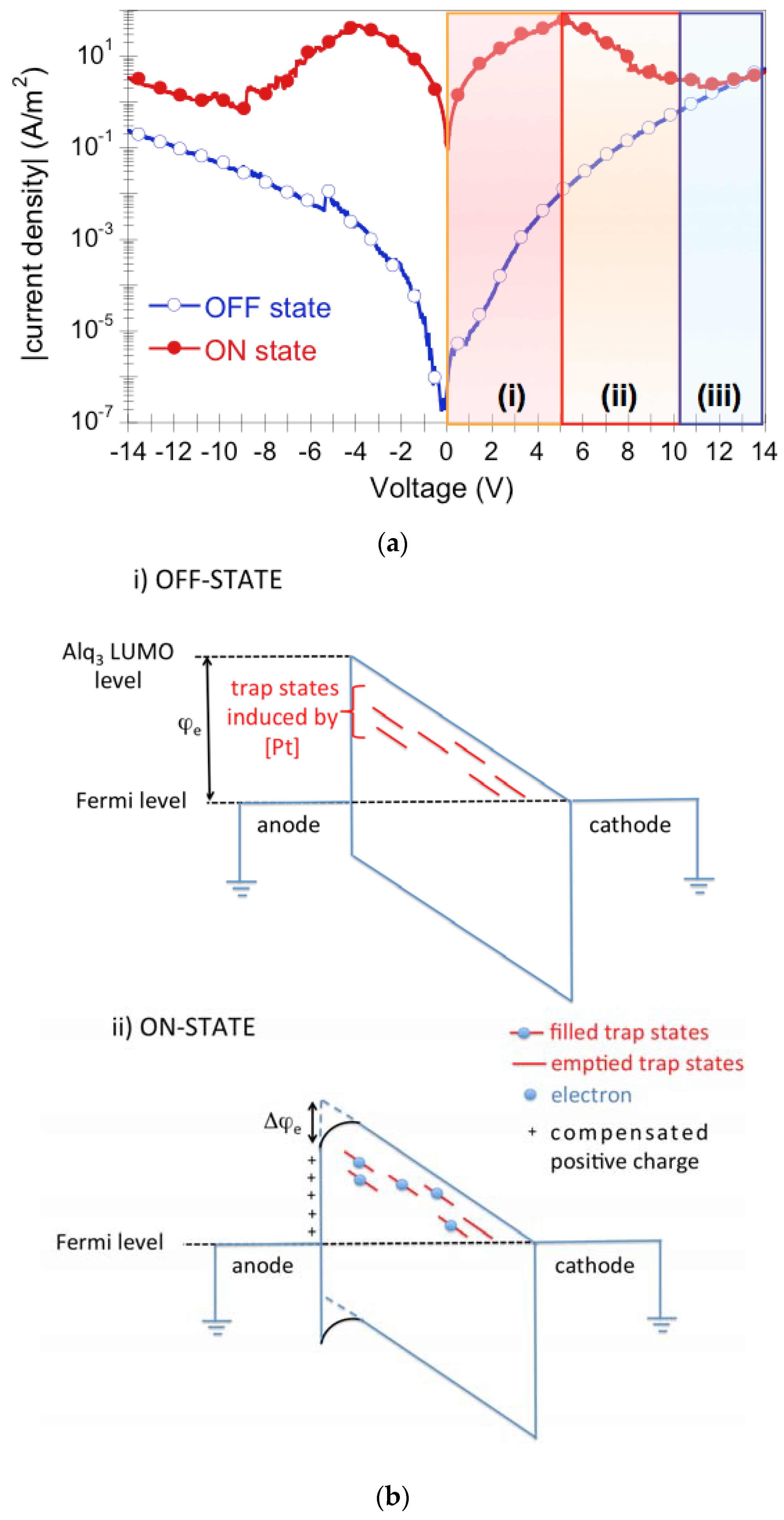


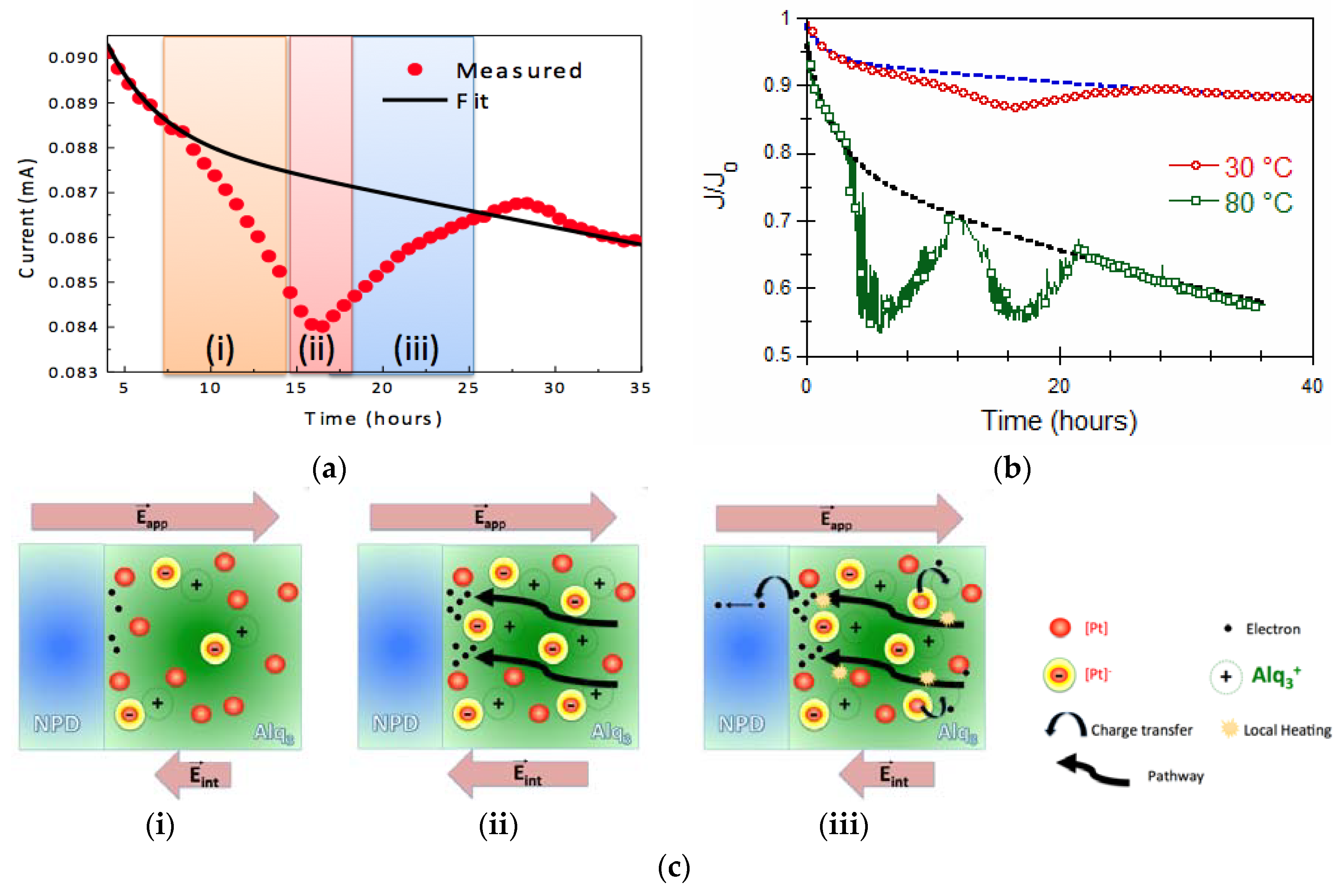
| Fast Decay | Long-Time Decay | |||
|---|---|---|---|---|
| τ (h) | B | τ (h) | β | |
| Non-doped device | 8.5 | 0.59 | 500 | 1.1 |
| Doped device | 1.5 | 0. 53 | 1500 | 1.2 |
© 2018 by the authors. Licensee MDPI, Basel, Switzerland. This article is an open access article distributed under the terms and conditions of the Creative Commons Attribution (CC BY) license (http://creativecommons.org/licenses/by/4.0/).
Share and Cite
Blondel, B.; Colin, A.; Lopes, M.; Alary, F.; Zissis, G.; Sasaki, I.; Renaud, C. Application of [Pt(II)(Tetra-Tert-Butylsalophen)] Complex within Organic Devices: Deep Red Emission, Bistable Light-Emitting Diodes and Operational Stability. Appl. Sci. 2018, 8, 762. https://doi.org/10.3390/app8050762
Blondel B, Colin A, Lopes M, Alary F, Zissis G, Sasaki I, Renaud C. Application of [Pt(II)(Tetra-Tert-Butylsalophen)] Complex within Organic Devices: Deep Red Emission, Bistable Light-Emitting Diodes and Operational Stability. Applied Sciences. 2018; 8(5):762. https://doi.org/10.3390/app8050762
Chicago/Turabian StyleBlondel, Benoît, Anaïs Colin, Manuel Lopes, Fabienne Alary, Georges Zissis, Isabelle Sasaki, and Cédric Renaud. 2018. "Application of [Pt(II)(Tetra-Tert-Butylsalophen)] Complex within Organic Devices: Deep Red Emission, Bistable Light-Emitting Diodes and Operational Stability" Applied Sciences 8, no. 5: 762. https://doi.org/10.3390/app8050762






